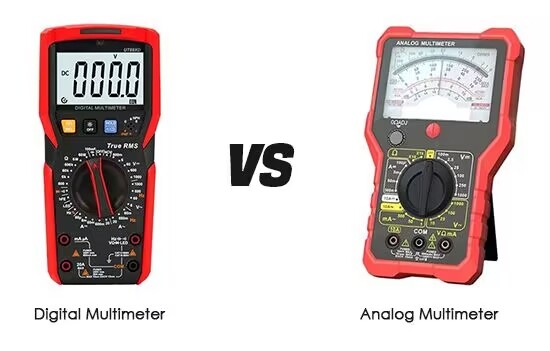A multimeter, also known as a volt/ohm meter or VOM, is widely used in electrical and electronic work to diagnose circuits, components, and devices. It is a versatile electronic measuring instrument that combines several measurement functions in one unit. A typical multimeter can measure voltage (volts), current (amperes), and resistance (ohms). Some advanced models can also measure additional parameters such as capacitance, frequency, temperature, and continuity. However, multimeters can be analog or digital, which one is the best? SISCO online shop will tell you the differences.
Introductions
Digital multimeter: A digital multimeter (DMM) is an electronic measuring instrument that combines several measurement functions in one unit. A typical DMM can measure voltage (both AC and DC), current (both AC and DC), and resistance. It can also perform other functions such as continuity testing, diode testing, capacitance measurement, and frequency measurement. Digital multimeters display readings in numeric form on a digital screen, providing precise and accurate measurements. They are widely used in various applications, including electronics, electrical engineering, and automotive repair, for troubleshooting and testing electrical circuits and components.
Analog multimeter: An analog multimeter is a type of electrical measuring instrument that uses a needle to indicate readings on a scale. It can measure various electrical parameters such as voltage (both AC and DC), current (AC and DC), and resistance. The needle moves over a printed scale to show the value of the measurement. Analog multimeters are valued for their ability to display changing trends in electrical measurements smoothly and continuously, which can be useful for detecting fluctuations or trends that might not be as easily seen on a digital display. Despite being largely replaced by digital multimeters in many applications, analog multimeter testers are still preferred in some situations for their simplicity and the visual clarity of analog signals.

Differences between Digital Multimeter and Analog Multimeter
1. Different Basics
- Digital multimeter: It adopts digital display technology, displaying measurement results through LCD screen.
- Analog multimeter: It adopts pointer dial and indicates the measurement result through pointer.
2. Different Working Principles
- Digital multimeter: A digital multimeter converts an input electrical signal into a digital signal through an analog-to-digital converter (ADC). The digital signal is processed and then calculated and displayed by a microprocessor.
- Analog multimeter: An analog multimeter drives a pointer-type meter directly using an incoming electrical signal. The signal is applied directly to the pointer through an internal mechanical device (e.g. ammeter, voltage divider, etc.), which indicates the measured value on a dial.
3. Accuracy and Precision
- Digital multimeter: Usually higher accuracy and resolution, suitable for precise measurement.
- Analog multimeter: Relatively low precision. Reading requires manual judgment of the position of the pointer, thus there may be a certain reading error.
4. Display Differences
- Digital multimeter: Measurement results are displayed using a liquid crystal display (LCD) or light emitting diode (LED), usually in digital form, for intuitive and accurate readings.
- Analog multimeter: Pointer display, need to manually adjust the range, readings need to be based on the dial scale.
5. Response Speed
- Digital multimeter: Typical digital multimeters have a refresh rate of 2-4 times/second, with some high-end models reaching 20 times/second or more. Their sampling rates are usually in the thousands of times/second, but this depends on the specific model and settings. Due to processing data and displaying results, digital multimeters may have some display delay, usually within a few hundred milliseconds.
- Analog multimeter: The analog multimeter's pointer response time is typically in the millisecond level, allowing it to quickly reflect changes in voltage or current. Because there is no digital processing, the dynamic response of an analog multimeter is much faster, especially when detecting rapidly changing signals.
6. Durability and Stability
- Digital multimeter: More electronic components, poor drop resistance, but good long-term stability.
- Analog multimeter: More mechanical structure, strong resistance to fall, but long-term use is prone to wear and error.
7. Function and Expandability
- Digital multimeter: Usually more functions, such as data retention, minimum/maximum value recording, automatic shutdown, etc.
- Analog multimeter: Relatively single function, poor expandability.
8. Application Scenarios
- Digital multimeter: Suitable for laboratory, maintenance and electronic development and other occasions that require high-precision measurement.
- Analog multimeter: Suitable for education and teaching, basic testing and occasions requiring fast response.
9. Price and Availability
- Digital multimeter: Wide price range, high popularity, easy to buy.
- Analog multimeter: Relatively cheap, but fewer choices on the market.
Conclusion
SISCO has summarized these differences for you to choose the best multimeter.
- Digital multimeter:
- Advantages: More accurate, user-friendly interface, easy to read and operate.
- Disadvantages: Higher price and less resistant to drops, slower respond and battery dependency. - Analog multimeter:
- Advantages: Lower price, higer resistant to drops, no need of battery and real-time display.
- Disadvantages: Less accurate, inaccurate reading, limited function, susceptible to interference and complicated calibration.
Therefore, which one is better, digital multimeter or analog multimeter, is actually depending on a lot of factors. The final recommendation is based on different user needs and applications.

